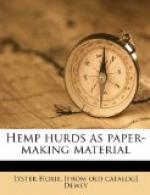In the process of breaking, the woody cylinder inside of the fiber-bearing bark is broken into pieces one-half of an inch to 3 inches long and usually split into numerous segments. The thicker lower sections are split less than the thin-shelled upper ones, and they are often left quite solid.
=Pith, wood, and fiber.=
The inner surface of the hurds usually bears a layer of pith, consisting of thin-walled cells nearly spherical or angular, but not elongated. They are more or less crushed and torn. They are probably of little value for paper, but they constitute less than 1 per cent of the weight of the hurds. The principal weight and bulk consist of slender elongated woody cells. The outer surface is covered with fine secondary fibers composed of slender elongated cells, tougher than those of the wood but finer and shorter than those of the hemp fiber of commerce. No method has been devised thus far which completely separates from the hurds all of the long fiber. From 5 to 15 per cent of the weight of the hurds consists of hemp fiber, in strands from 3 inches to 8 feet in length. Some fragments of the bark, made up of short cubical cells, usually dark in color, cling to the strands of fiber.
=Character of hurds affected by retting.=
Nearly all of the hemp in the United States is dew retted. The stalks are spread on the ground in swaths as grain is laid by the cradle. The action of the weather, dew, and rain, aided by bacteria, dissolves and washes out the green coloring matter (chlorophyll) and most of the gums, leaving only the fibrous bark and the wood. The plants in this process lose about 60 per cent of their green weight, or about 40 per cent of their air-dry weight.
The stalks are sometimes set up in shocks to cure before retting, and after retting they are set up in shocks to dry. Each time the stalks are handled they are chucked down on the ground to keep the butts even. In these operations sand and clay are often driven up into the hollow at the base of the stalks, and this dirt, which often clings tenaciously, may constitute all objectionable feature in the use of hemp hurds for paper stock.
In Italy and in most localities in Russia and Austria-Hungary where hemp is extensively cultivated, it is retted in water, but water retting has never been practiced in the United States except to a limited extent before the middle of the last century. Hurds from water-retted hemp are cleaner and softer than those from dew-retted hemp.
The fiber is sometimes broken from dry hemp stalks without retting. The hurds thus produced contain a small percentage of soluble gums, chiefly of the pectose series. Comparatively little hemp is prepared in this manner in America.
Process retting by means of weak solutions of chemicals or oils in hot water is practiced to a limited extent. The hurds from these processes may contain traces of the chemicals or oils and also soluble gums in greater degree than those of the dew-retted or water-retted hemp.




